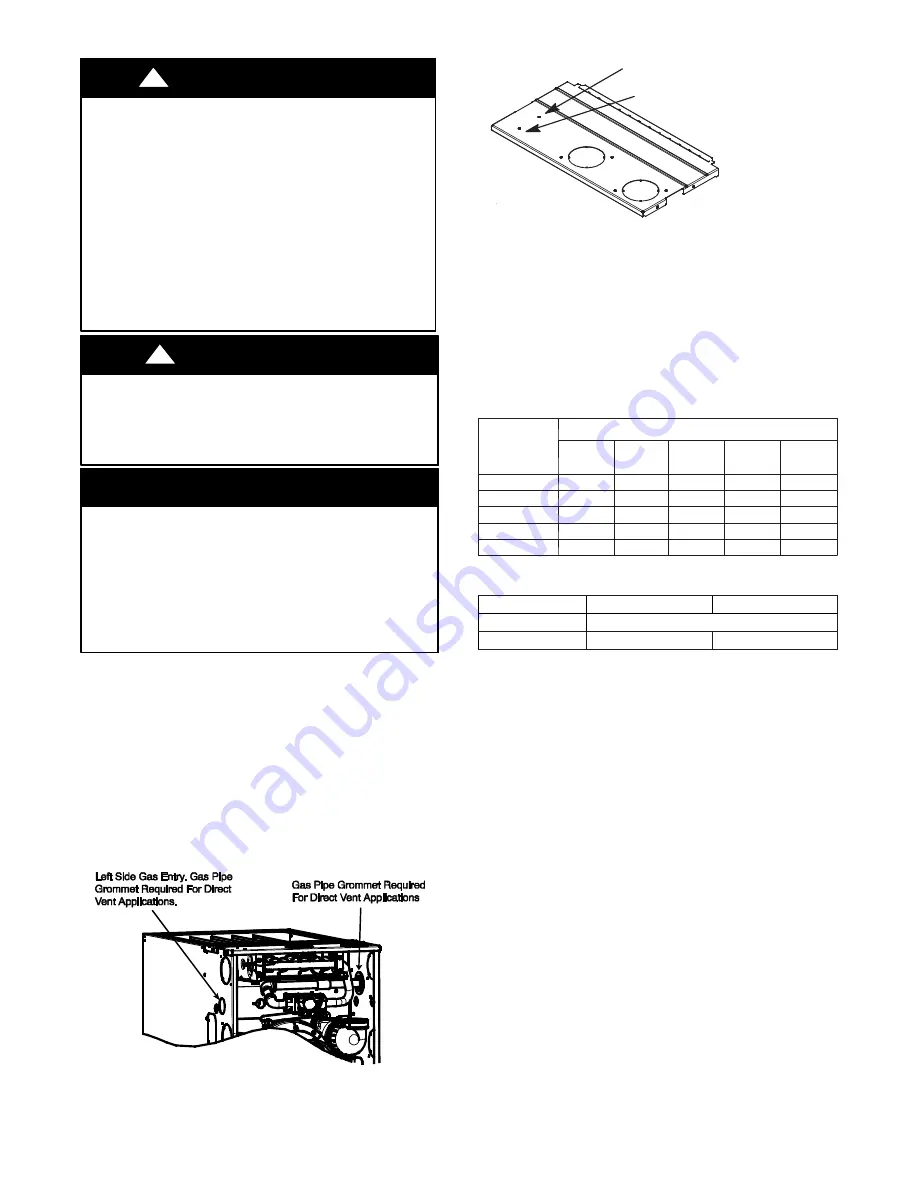
440 01 6201 00B
25
Specifications subject to change without notice.
GAS PIPING
FIRE OR EXPLOSION HAZARD
Failure to follow this warning could result in personal
injury, death, and/or property damage.
Never purge a gas line into a combustion chamber. Never
test for gas leaks with an open flame. Use a commercially
available soap solution made specifically for the detection
of leaks to check all connections. A fire or explosion may
result causing property damage, personal injury or loss of
life.
Use proper length of pipe to avoid stress on gas control
manifold and gas valve.
Gas valve inlet and/or inlet pipe must remain capped until
gas supply line is permanently installed to protect the valve
from moisture and debris. Also, install a sediment trap in the
gas supply piping at the inlet to the gas valve.
!
WARNING
FURNACE DAMAGE HAZARD
Failure to follow this caution may result in furnace damage.
Connect gas pipe to furnace using a backup wrench to
avoid damaging gas controls and burner misalignment.
CAUTION
!
In the state of Massachusetts:
1. Gas supply connections MUST be performed by a licensed
plumber or gas fitter.
2. When flexible connectors are used, the maximum length
shall not exceed 36 in. (915 mm).
3. When lever handle type manual equipment shutoff valves
are used, they shall be T--handle valves.
4. The use of copper tubing for gas piping is NOT approved
by the state of Massachusetts.
NOTICE
Gas piping must be installed in accordance with national and local
codes. Refer to current edition of NFGC in the U.S.A. Refer to
current edition of NSCNGPIC in Canada.
Installations must be made in accordance with all authorities
having jurisdiction. If possible, the gas supply line should be a
separate line running directly from meter to furnace.
NOTE
: Use a back--up wrench on the inlet of the gas valve when
connecting the gas line to the gas valve.
The gas supply pressure shall be within the maximum and
minimum inlet supply pressures marked on the rating plate with
the furnace burners ON and OFF.
Gas entry can be from left or right side, or top panel. See
Fig. 29
and
30
.
A11338
Fig. 29 -- Gas Entry
1
ï
1/2 inch for Gas
7/8 inch for 115 VAC Electric
A170125
Fig. 30 -- Alternate Gas and Electric Entry
NOTE: Top plate may be field drilled for alternate gas and
115 VAC electric entry.
Refer to Table 10 for recommended gas pipe sizing. Risers must be
used to connect to furnace and to meter. Support all gas piping
with appropriate straps, hangers, etc. Use a minimum of one hanger
every 6 ft. (2 M). Joint compound (pipe dope) should be applied
sparingly and only to male threads of joints. Pipe dope must be
resistant to the action of propane gas.
Table 10 – Maximum Capacity of Pipe
NOMINAL
IRON PIPE
SIZE
IN. (MM)
LENGTH OF PIPE --- FT (M)
10
(3.0)
20
(6.0)
30
(9.1)
40
(12.1)
50
(15.2)
1/2 (13)
175
120
97
82
73
3/4 (19)
360
250
200
170
151
1 ( 25)
680
465
375
320
285
1-1/4 (32)
1400
950
770
660
580
1-1/2 (39)
2100
1460
1180
990
900
* Cubic ft of gas per hr for gas pressures of 0.5 psig (14---in. w.c.) or less
and a pressure drop of 0.5---in. w.c. (based on a 0.60 specific gravity gas).
Ref: Table 10 above and 6.2 current edition of NFPA54/ANSI Z223.1.
Gas Pressure
Natural (in W.C.)
Propane (in W.C.)
Maximum
13.8
Minimum
4.5”
12”
When a flexible connector is used, black pipe shall be installed at
the furnace gas control valve and extend a minimum of 2--in. (51
mm) outside the furnace.
For direct vent (2--pipe) applications, seal the gas pipe knockout to
prevent air leakage.
Remove the required knockout.
Install the grommet in the
knockout. Then insert the gas pipe. The grommet is included in
the loose parts bag.
Piping should be pressure and leak tested in accordance with the
current addition of the NFGC in the United States, local, and
national plumbing and gas codes before the furnace has been
connected.
Refer to current edition of NSCNGPIC in Canada. After all
connections have been made, purge lines and check for leakage at
furnace prior to operating furnace.
PRESSURE TESTING ABOVE
½
psig:
The furnace and it’s individual shut--off valve must be
disconnected from the gas supply piping system during any
pressure testing of that system at test pressures in excess of
½
psig
(3.5 kPa).
PRESSURE TESTING BELOW
½
psig:
The furnace must be isolated from the gas supply piping by closing
its individual manual shut--off valve during any pressure testing of
the gas supply piping system at test pressures equal to or less than
½
psig (3.5 kPa).
















































